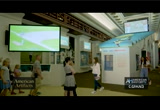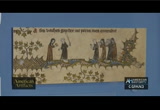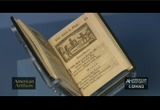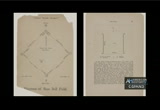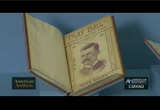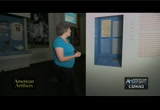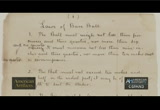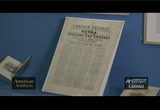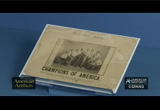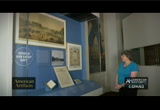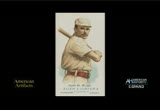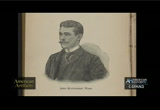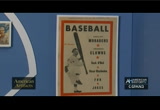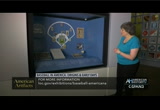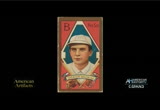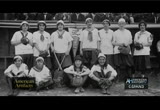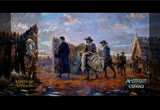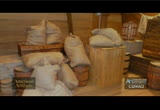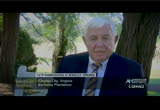tv American Artifacts Baseball in America - Origins Early Days CSPAN November 25, 2018 2:00pm-2:26pm EST
2:00 pm
those intentions will likely translate into action. organizations know where we are, who we are connected with, no our feelings, no our intentions. openly invited them into the brightest and darkest corners of our lives. announcer: watch the communicators monday night at 8:00 eastern on c-span two. >> each week, american artifacts takes you into museums and historic sites around the country. next, the baseball americana exhibit and the library of congress and washington, d.c., to learn about baseball's origin and early days. >> welcome to the library of congress. i am susan raven, curator of the exhibition baseball americana. this is a collaboration with major-league baseball, espn and the baseball hall of fame in cooperstown. we have things you have probably never seen before.
2:01 pm
let's start with some of the earliest. are standing in front of the exhibit, looking at origins and early days, where we had interesting artifacts that suggest baseball has a history that is much longer than the 19th century. in fact, we have an example from a medieval manuscript. these are miniature figures that were part of the border of a book produced in 1344. do you can see we have a monk in a none -- a nun primitive outfield. it shows you that that and gamesmes -- bat and ball were being played long before baseball. cuteext stop is this little book i absolutely adore. it is one of my favorites. it is a pretty pocketbook from 1787. it includes a woodcut drawing of
2:02 pm
children playing baseball with three posts, the word baseball printed there, and a poem suggesting that a boy runs home with the joy. already, the lexicon is showing up. this was first produced in 1744 in britain. is not until he comes to the united states in 1787 that the word first desk it is not until it comes to the united rates in 1787 that the -- it is not an till it comes to the united states in 1787 that word first appears. 22, a fine,, march played baseball but am beaten for i cannot catch or hit. he is not a great player. the following year, the college faculty will ban baseball as being unbecoming of a gentleman.
2:03 pm
this is the earliest written reference we have to baseball. already, the game is on college campuses. already, it is being played by boys that are much older than children these are probably. although than children. we have an example of the new your games. there is the familiar diamond we are always too. -- all used to.
2:04 pm
this blowup of the illuminated manuscript. pages.re all original one of the things that surprises a lot of people when they come to the library of congress and they see this exhibit or they hear us talking about it is that we have very large sports collections. we are a premier sports archive, if you will come a here at the library. through copyright, we have received everything from early rulebooks to team directories to handwritten histories of leagues and things. there is a great deal of material we have to work with in documenting not just baseball, but a number of. next, i want to show you something that was recently rediscovered that had been hidden away in a desk drawer for years. no one really realized the importance of it until recently. these are the founding documents of american baseball. so here we are in front of what has and called baseball's magna
2:05 pm
carta. these are the founding documents used at the 1857 baseball convention in new york city that laid out the rules of the game that we have come to know as american-based all. -- american baseball. gathered a dozen other teams and presented a series of rules they could all adopt to develop a standard, uniform game. up until that time, teams but -- teams played by different rules. you could not have meaningful competition while that was going on. drafted what he called the laws of baseball. those were combined with william gounod's match rules of baseball. through those two documents the mother put together this red-rated document that the rules committee used at the convention. it is here out of these sessions that several major essential,
2:06 pm
fundamental rules were developed. nine players to aside, nine innings in a game, 90 feet between the basis. some of the things that we have come to accept as the essentials of baseball, this is where they are agreeing to the rules, or they are coming from. the documents were not known to really exist until 2016. after the convention, they wound up in the hands of william gounod's granddaughter -- william rundell -- grunell's granddaughter. when they went on auction in 2016, historians were able to do some forensic and historical announces and determined that these were incredibly valuable papers. they had not in scene widely. this was the first major exhibition for what is called baseballs mena carta that has been on display. we are excited that they are
2:07 pm
here at the library. it is almost as important in some ways as some of our other founding document. next, we take a look at how baseball spread across the united states. we are continuing with his balls origins and early days. a good way to demonstrate that is with the earliest baseball coverage of an intercollegiate game. this first intercollegiate game is between average and pittsfield, massachusetts, 1859. they were playing by the massachusetts rules. the scoring was clearly a little bit different. amherst 73, williams 32. but the importance of this document, probably the only original that still survives, is that this is an early stab at sportswriting. a lot of the coverage involves how the players arrived at the game site, how they like their hotel, accommodations, things like that. it is an unusual document. the game was part of a doubleheader, baseball and
2:08 pm
chess. one day, they played baseball. the next day, there was a chess match. coverage of the chess match is on the other side as well. we have an early box score that shows the names of the players, the tallies, the number of they came homes, and the number of outs that they made. after that, after the civil war, we have what is concerned -- considered a prototype for baseball cards, the earliest assisting baseball cards. it is the brooklyn atlantics, chickens of america. they went to the studio and had their photo taken. they would hand these out to their fans and admirers and two opposing team. another 20 or more years before manufactured baseball cards, as we come to know them, are being produced. this is probably the earliest example of a trading card. up here, this is an example of the game spreading across the united states. the civil war was a huge
2:09 pm
catalyst for spreading baseball. a lot of the northern soldiers introduced it to southerners in prison caps. this is an original print produced during the war. you see a game going on. as the war continued, the likelihood that they were playing baseball in prison cancer greatly diminished. but early in the war, there are documented incidents of this happening. finally, after the war, 1869, cincinnati red stockings become the first professional baseball, the first gene that is professionally paid during not clubafter that, other owners decide we are not what have amateurs in the game anymore. we are paying everyone. this is their undefeated season in 19 -- in 1869. we got professional teams and soldiers after the work or taking the game westward. more people are playing.
2:10 pm
let's take a look at who those folks are. this is a section on who's playing back in the 19th century. just about everyone is. but the only people who are being paid for it is white men on medially baseball teams. what we have here from 1887 is baseball cards from the first years they are being produced. tobacco companies would tuck in individual cards into their cigarette packages as a way of promoting not only their products but you can collect the number of packages and submit it later for a bigger card. what is interesting about the national baseball cards here is that they are uncut. those are pretty rare. you don't find that often. this was submitted for copyright rate here at the library of congress. we have a larger set from 1994 also uncut. submitted for copyright. although some of those poses
2:11 pm
stayed the same, the diversity of the players have changed tremendously. you had more black and hispanic layers, which you do not have in the 1880's. one of the most important people of that era and in baseball history was john montgomery ward. he wrote the book "how to become a player. -- "how to become a player." he is one of the first to write the book, also an attempt to look at the actual historical origins of baseball. he spends most of his time as a picture, later as a shortstop, working to improve the life of the average baseball player, who usually picked up low-paying jobs in the off-season as a farmer or railroad worker. he fought against what became known as the reserve clog in baseball. -- clause in baseball. this was a clause that was included in all contracts for players in which their rights were held by the club of perpetuity. unless a player was traded or sold to another team, he had no
2:12 pm
say in where he played or even how much he was paid. this clause assuming the baseball players are going to battle throughout much of the 20th century as well. it really starts with john montgomery ward. in 1890, he a most single-handedly forms the players league, which was in opposition to the national league and american association. it only lasted one year. even though he was able to attract a lot of star players in the league, they could compete financially against the established teams in the national league and american association. ultimately, it fell apart after a year. this was an attempt to control their own destiny and determine how much they were paid and how much they were worth. from the 1880's on, until 1947, major league baseball was played only by weight men, but that starts to change. we will take a look at the negro leagues in the next case.
2:13 pm
for black players who are not permitted to play in the major leagues, a lot of them started their own barnstorming teams. we have an example of a team in the 1880's. it's not until 1920 that they established the actual negro league, which is a professional league. there were a number of incarnations. a number of teams participated in that. we have an example from the indianapolis clowns. a signed baseball by satchel paige, a phenomenal pitcher who got his start for many years in the negro league, doesn't become a rookie in the major league until he's 42. he continues to pitch until he's 59. while african-americans are having to make their way with their own legs, other brands of baseball are developing. we have an image of the indoor champion baseball team.
2:14 pm
indoor baseball was invented in 1887 in chicago. it was a way for teens to keep in shape in the off-season. almost immediately indoor baseball moves outdoors. what characterizes indoor baseball is larger balls, smaller bats, smaller diamonds 1926 thatt until indoor baseball adopts the name that most of us know the game as as. that's softball. while black players were not get in the publicity why players were, they were not, that was the domain of white players. we have a fantastic collection of really early baseball cards from 1887 to 1914, all of these cards are original, they represent a different set or brand of cards that appeared.
2:15 pm
small cards are only two inches long. we have batting. that was called a turkey red. those are premium cards and if you send in enough cigarette packages you could trade that in. and receive a large premium card. these cards are part of the benjamin k edwards collection. cards not only baseball players but trustee, but trapeze artists, focus performers,
2:16 pm
billiards players, and all kinds of athletes that appeared on these cards. the popularity of baseball was such that most people were interested in collecting those cards. eventually tobacco companies turned to only producing baseball cards. the other people not featured on baseball cards were female players. there were women out there playing organized teams and organized leagues as well. we will take a look at them. other people playing in the game where women in the 19th century. -- were women in the 19th century. this is a fantastic team from 1913, the new york female giants. their captain excelled in every sport, including cliff diving. she had a short show business career on the stage in broadway, on broadway and in silent films. what most people learn about is the first professional league, developed in world war ii, the first all-american leak, it was -- all-american league. it was established as a way to entertain the homefront during the war and provide professional baseball while most of the men were away. we have the original jersey for the rockford peaches. you can imagine those of a
2:17 pm
-- you can imagine that was pretty difficult to achieve given that she was having to slide into such a short uniform. some of the sleeves show the wear and tear over the years. she went of stealing 460 bases in her 10 year career. we also shed some light on girls breaking into little league. a number of lawsuits were filed in the 1970's. it's not until 1974 that girls were able to join the little league teams. you take it to the furthest degree. here we have monet davis after she threw a winning game in the world series for little league. black ballplayers had a shot at the major leagues in 1947. the first one to break the color line was jackie robinson. larry adobe will do that two months later in the american league. jackie robinson's plane for the
2:18 pm
jackie robinson was playing for the dodgers in the national league. the library is very fortunate to have the branch and the jackie robinson collection. that's where we are able to draw a couple of items, including this letter from jackie in 1950, written to branch rickey who was leaving the dodgers. and robinson's writing to let him know how grateful he is for the brakes that ricky gave him in signing the dodgers, letting him know he was a trusted friend and he hopes ricky will think of him as a friend in return. it's a very heartfelt letter thanking him for everything he had done for himself and his family. what we have here is the original first page of jackie robinson's letter. on the back is a reproduction. in order to preserve this letter and keep it from being affected by the lights and the wear and tear of being on exhibition we will eventually swap these out. what we have on display then is the original signature of jackie
2:19 pm
later on in the exhibitions run. what we have seen here so far is only half of the exhibits. there is a lot more to see. so if you are in washington, d.c., please come to the library of congress and check out the exhibition. >> you can watch this or other programs anytime by visiting our website, c-span.org/history. >> who was martin van buren? >> good question. a lot of people probably need to ask that question. martin van buren was the eighth president of the united states. he is often forgotten. his presidency was only four years long. witmerght on "q&a," ted on his biography of martin van buren. >> the spent a lot of time with
2:20 pm
aaron burr, hamiltons murderer. there were persistent rumors that even gore rudolph planted them in his novel that martin van buren may have been the illegitimate son of aaron burr. we don't know. no one will ever know. but john quincy adams once wrote in his diary that martin van buren looks a lot like aaron burr and acts a lot like aaron burr. he is always try to organize factions and get southerners and northerners in political alliances with one other. "q&a."ght on c-span's artifactsek, american takes you to museums and historic places to learn about american history. here is a look at one of our recent. >> what they needed to do first
2:21 pm
is find a leader. that leader was john woodlief. after looking at certain people, several people, they chose captain john woodlief to lead the expedition to the new world. john woodlief had been to the new world several times. he wasn't ancient planter, which was a title of distinction in those days -- he was an ancient planter, which was a title of distinction in those days. he had been to the new world, experienced the new world, and experienced leadership in the expedition. a group in london made him a captain in the first governor of the colony. he set on to his task of leading the expedition to the new world. what he had to do first was lease a ship. he released the good ship margaret from edward williams in bristol, england, in 1619. its name was the margaret. it was due to take off for the new world on september 16.
2:22 pm
next, captain woodlief had to get a crew. he found men that were capable of building a settlement. they were carpenters, journeyman , those kinds of professions that were craftsmen, who knew how to build a sturdy settlement that would last for a long time. so he chose 35 men. to go across as the settlement progressed. next, he needed provisions for the ship. he started to do that. he had food. that included skits and bread, -- biscuits and bread, wheat, bacon and horsemeat and other kinds of things like that. he also had beer, cider, and itae, i take -- and aqua v which was an alcoholic drink in those days. he had tools, kitchen utensils, bibles, and 6000 beads to trade with the indians. there were a lot of things on
2:23 pm
that ship that went over. the margaret itself was a small ship. it was only 35 feet long at its keel and weighed 47 tons. so it was one of the smallest ships of that period. theyen come in fact, when went across the russian, probably had to sleep on the top deck of that ship because there was not room underneath because of the supplies that were there deck.ep underneath the so they took offense at him or 16, 6019, at 8:00 in the morning. it was a beautiful morning -- 1619, at 8:00 in the morning. it was a beautiful morning. they left of bristol, england and went forth on their journey. unfortunate, there was not a lot of went. so on the seventh day of the cruise, a small gale came up and pushed them forward. they spent two and a half months on the atlantic ocean. they were claustrophobic. they were homesick. . there was very manifestation. on, a lota lot going
2:24 pm
of difficult times for them during that two-and-a-half month span. also, many storms to place. but they made it, and they made it to the hampton rosaria -- hampton rose area. they anchored for the night and then a gale came up. a shred strong. -- a should storm, which is what it is called. they worried they would not make it through the night, but they prayed constantly. they did make it through the night and then headed up to james river, to their destination. >> travel with us to historic sites, museums, and our kites -- and archives on our weekly artifacts."ican this is american history tv all weekend on c-span 3. >> samuel goldman discusses the history of christian zionism in america. he defines this as the belief
2:25 pm
that christians have a religious responsibly to promote and support a jewish state in some portion of the political holy land. he is the author of "god's country, christian zionism in america. -- in america. i want to thank you all and welcome you to the washington history seminar on national and international affairs. i am the cochair of this seminar. ,oday, my other cochair christian osterman, is unable to join us. some of you know some of you do not know. this is a seminar that has been going on for a good number of years. it is the collaborative effort of two organizations, the national history center, which is a part of the american historical association, and the woodrow wilson international nt
50 Views
IN COLLECTIONS
CSPAN3 Television Archive
Television Archive  Television Archive News Search Service
Television Archive News Search Service 
Uploaded by TV Archive on

 Live Music Archive
Live Music Archive Librivox Free Audio
Librivox Free Audio Metropolitan Museum
Metropolitan Museum Cleveland Museum of Art
Cleveland Museum of Art Internet Arcade
Internet Arcade Console Living Room
Console Living Room Books to Borrow
Books to Borrow Open Library
Open Library TV News
TV News Understanding 9/11
Understanding 9/11